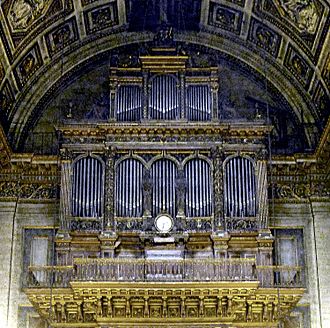Oratorio de Noël facts for kids
Quick facts for kids Oratorio de Noël |
|
|---|---|
| Cantata by Camille Saint-Saëns | |

The Aristide Cavaillé-Coll organ at La Madeleine, where the music premiered
|
|
| English | Christmas oratorio |
| Opus | 12 |
| Text | from the Vulgate |
| Language | Latin |
| Performed | 24 December 1858: Paris |
| Published | 1863 |
| Movements | 10 |
| Scoring |
|
The Oratorio de Noël (which means Christmas Oratorio) is a beautiful piece of music by Camille Saint-Saëns. It's like a special musical story, written for singers (soloists and a choir), an organ, a harp, and string instruments. Saint-Saëns wrote this amazing work very quickly, in less than two weeks! He finished it just ten days before it was first performed on Christmas Eve in 1858. At that time, he was the organist at a famous church in Paris called La Madeleine.
Contents
Who Performs the Music?
This musical piece uses five main singers: a soprano (high female voice), a mezzo-soprano (medium female voice), an alto (low female voice), a tenor (high male voice), and a baritone (medium male voice). It also features a mixed choir, which means it has sopranos, altos, tenors, and basses singing together.
The instruments include an organ, a harp, and string instruments like violins and cellos. The organ is very important in this piece, often playing by itself. The harp is used in only three parts of the music.
What is the Story About?
Saint-Saëns chose words from the Latin Vulgate Bible for the text of his oratorio. The Vulgate is an old Latin version of the Bible. Even though the texts come from different parts of the Bible, they are all connected to traditional Christmas church services. About half of the texts he picked are from two special Christmas services: the First Mass at Midnight and the Second Mass at Dawn.
One part of the story, found in the second movement, tells about the shepherds from the traditional Christmas story. The rest of the words, taken from other books of the Bible like John, Isaiah, Lamentations, and the Psalms, help us think about the deeper meaning of Christmas.
How is the Music Organized?
The Oratorio de Noël is organized into 10 different parts, called movements. It starts with a "Prélude" (which means "prelude" or "introduction") played by the organ and strings. After this, there are nine parts with singing.
The music slowly builds up. It starts with just one singer and a small group of instruments. Then, more singers and instruments join in. The full choir sings in the second, sixth, and last movements. In the fourth movement, the women of the choir sing along with the tenor soloist.
Most of the music is calm and beautiful, like a gentle song. But there are also some grand parts for the solo singers and one exciting part for the choir. Saint-Saëns learned a lot from other famous composers like Bach, Handel, and Mozart. Their music greatly influenced how he wrote this oratorio.
The 10 Musical Parts
Here are the different movements (parts) of the Oratorio de Noël:
- Prélude (dans le style de Seb. Bach): This is an introduction played by the organ and strings, in the style of the famous composer J.S. Bach.
- Recitative: “Et pastores erant”; Chorus: "Gloria in altissimis": This part features soprano, alto, tenor, and baritone soloists with the organ and strings. The choir then sings "Glory in the highest."
- Air: "Exspectans expectavi": A beautiful song for the mezzo-soprano soloist, with organ and strings.
- Air and chorus: “Domine, ego credidi”: The tenor soloist sings with the women's choir, organ, and strings.
- Duet: “Benedictus”: A song for two singers, the soprano and baritone soloists, with organ and harp.
- Chorus: “Quare fremuerunt gentes”: The mixed choir sings with the organ and strings.
- Trio: “Tecum principium”: A song for three singers: soprano, tenor, and baritone soloists, with organ and harp.
- Quartet: “Laudate coeli”: A song for four singers: soprano, mezzo-soprano, alto, and baritone soloists, with organ and strings.
- Quintet and chorus: “Consurge, filia Sion”: All five soloists sing together with the choir, organ, strings, and harp.
- Chorus: “Tollite hostias”: The mixed choir sings this final part with the organ and strings.
See also
 In Spanish: Oratorio de Noël para niños
In Spanish: Oratorio de Noël para niños

